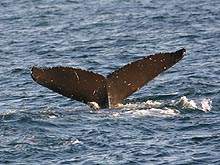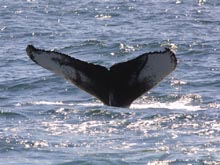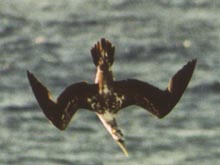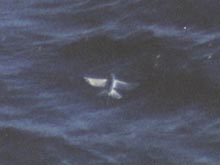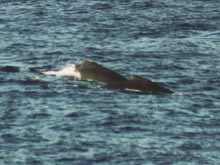
The dorsal fins of two humpback whales appear as they cruise past the ship. Click image for larger view and image credit.
Marine Mammal Observations in the Puerto Rico Trench
Amy Kennedy and Rebecca Lester
Marine Mammal Observers
The waters surrounding Puerto Rico have long been important breeding habitat for humpback whales. These whales summer in the cold northern latitudes, where there are plenty of small fish and krill to feed on, and then migrate south for the winter to breed. Silver and Navidad Banks, to the northeast of Puerto Rico, are shallow reef systems that provide warm protected waters for expectant mothers and their new calves. While the area is known for its breeding population of humpback whales, many other species have also been observed in the region. These include Bryde's, sei, fin and minke whales, as well as a host of smaller whales such as the pantropical spotted dolphin.
Marine mammal surveys are important for several reasons. First, they provide an indication of the different species in an area. Second, surveys illuminate migratory and reproductive patterns. Species such as humpback whales are easily identified by their natural markings. Each humpback whale has a distinctive pattern on the underside of its fluke. This pattern can range from entirely black to entirely white, but it is often a combination of black and white with unique scars and markings. Other whale species can be identified by their dorsal fin, their saddle-patch markings or other distinctive features. Marine mammal observers typically photograph this pattern and then compare it to a catalog of known whales. For more information on identification and naming of humpback whales, refer to the Center for Coastal Studies ![]() . Date, time, location and behavior, among other variables, are recorded for each whale sighting.
. Date, time, location and behavior, among other variables, are recorded for each whale sighting.
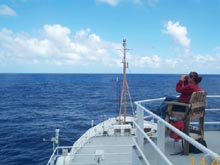
Amy scans the horizon for blows -- the first sign of a whale's presence. Click image for larger view and image credit.
On a typical survey, marine mammal observers search for whales, using binoculars, between dawn and dusk. For the most part, it is not possible to use electronic devices to locate the whales. Depending on the survey, special equipment may be used to collect data, including big eyes (4x25 mounted binoculars), data loggers (computer programs that record GPS and other data), 35 mm cameras with 300 mm lens (for photo identification), cross bows (used for biopsy darting) and hydrophones (to record whale vocalizations). However, the most important tool for a survey is a good set of binoculars and an attentive observer.
This survey of the Puerto Rico Trench was the first time that marine mammal observers have been aboard the NOAA Ship Ronald H. Brown. This posed some interesting logistical problems, most notably a lack of suitable amenities. To rectify the situation, Bruce, the chief boatswain, and his crew erected lifeguard chairs and positioned them on the forward bridge deck. After two days on the forward deck, and the mammal observers' subsequent sunburn, windburn, dreadlocks and heat rash, it was apparent that there was no shelter from the elements on that part of the ship! Bruce came to the rescue again, fashioning two large round hats to shield us from the sun.
Sightings on the cruise were primarily of humpback whales, consistent with their prevalence in the area. While on their breeding grounds, humpbacks are known to be extremely active. Many of the whales sighted on this trip were what are called "surface active" groups; that is, they were seen breaching and lobtailing. Other species observed included the pantropical spotted dolphin, possibly a minke whale, and another Stenella sp. dolphin.
On days when there were few marine mammals, we were fortunate to observe plenty of seabirds and flying fish. Bird species included red-footed, masked and brown boobies, magnificent frigatebird, white-tailed tropicbird, Wilson's storm petrel, Cory's and greater shearwaters and even a lost homing pigeon. The flying fish are fascinating creatures that explode from the water in small groups every few minutes, and have an incredible knack for frustrating any attempts at being photographed.
Between the building of the chairs, the constant stream of visitors hoping to see whales, the never-ending sun block applications, attempts at photographing birds and flying fish, gale-force winds, and, of course, the whales, there was never a dull moment.






